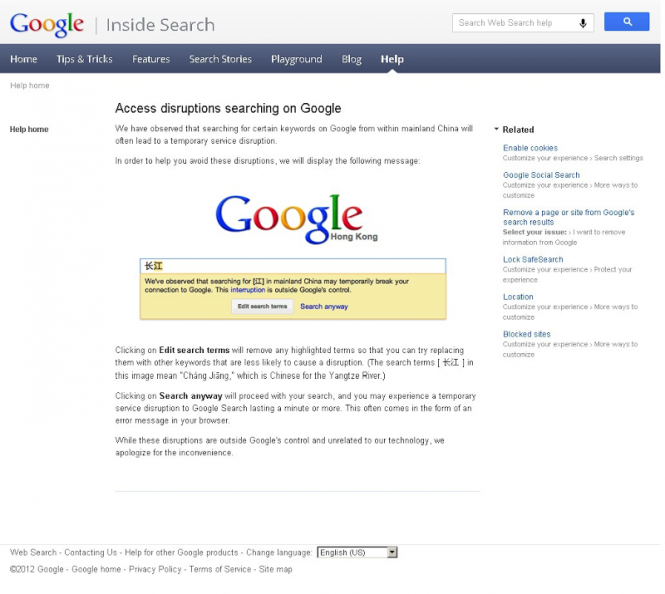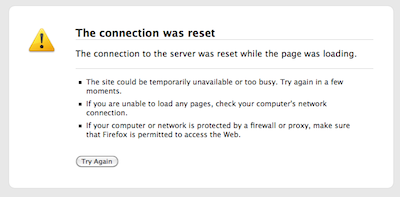Google Bows Down To Chinese Government On Censorship
Sometime between December 5 and December 8 last year, Google made a surprising decision that hasn’t yet been reported. They decided to remove a feature which had previously informed users from China of censored keywords (screenshot below). At the same time, they deleted the help article which explained how to use the feature. This indicates a new development in the relationship between the Chinese government and Google. Since Google moved its search engine to Hong Kong in 2010, censorship of its services such as YouTube, Google Plus and thousands of keywords on Google Search has been done by the Great Firewall, out of control of Google. This latest move was fully controlled by Google and can as such only be described as self-censorship.

Google has been depicted as a model company that stands up to the Chinese government and upholds its famous motto “Don’t be evil”. This impression reached a climax in May this year when Google introduced a new warning message aimed at users in China. Typing one of the many keywords blocked by the Great Firewall, this message would inform the user that continuing the search would probably break the user's connection. It was a bold step towards exposing the censorship that the authorities desperately try to hide. At the time, Foreign Policy asked whether in this “second clash between the Internet search giant and the Chinese government, will freedom of speech win?”.
Within 24 hours of Google’s new feature, The Great Firewall had struck back by blocking the javascript file containing the function and blocked keywords data (see Timeline Of Events below for more). Google in turn reacted by changing the URL of this file, which again was blocked. The cat and mouse game ended before the end of the month when Google geniously embedded the whole function in the HTML of its start page. This made it technically impossible to block the new function without blocking Google altogether.
This was a remarkable victory against censorship. Unfortunately, it didn’t last. According to our test data, Google switched off the embedded function for Chinese users sometime between December 5 and December 8. Why did they pull the switch?
One theory is that embedding the China-specific function on Google’s front page makes the system more difficult to maintain. The more complex a system is, the harder it is to improve. On the other hand, this function was clearly valuable. And with all the brilliant minds Google has at its disposal, they could surely find a technical solution. Though Google’s market share in China is only around 5%, that still translates to more than 25 million Internet users.
What really renders this theory void is that Google also deleted the help article about this function. While disabling a feature could potentially be a result of technical streamlining, deleting a help article and so pretending that the feature never existed makes no sense. The article used to be available at http://www.google.com/support/websearch/bin/answer.py?answer=2477913 but trying to view it now renders a “Page not available” message. Our test data shows that the article was still available on December 5 and that it had been removed by December 8. This is the same time that the function itself was disabled. Here’s a screenshot of the original help article:

What could be the reason for Google to switch off their smart anti-censorship function and at the same time delete the help article about the same function? The developers who painstakingly constructed it only half a year ago must have screamed in protest. Since the removal of the help article could only be done willingly by Google, the only explanation we see is that Google struck a deal with the Chinese government, giving in to considerable pressure to self-censor.
How did the Chinese government force such a candid company to do its bidding? Perhaps the complete blocking of Google Search on Nov 9 was part of it. The block was lifted after less than 24 hours making the move look very peculiar. At the time we speculated that perhaps it was a test of a “block-all-of-Google” button, but this new theory of it being part of pressuring Google looks at least as likely. It may have been an instance of the government showing off its power to Google and using it as a leverage in their negotiations.
Also in November, the throttling and partial blocking of Google’s Mail service was stepped up considerably. In the end, Google may have decided that providing a restricted version of Google Search and a slow but usable Gmail to Chinese users is much better than being completely cut off.
This is a grave setback in the fight against censorship and Google has been caught on the wrong side. It suggests that Google’s reputation as a fighter of censorship may not be fully earned. However, it’s not obvious that any other company is much better (see these stories critical of Microsoft, Apple and Yahoo). Gmail may still be the best email service for Chinese dissidents because it supports https, two-step authentication, and warns against suspicious activity and state-sponsored attacks. We appreciate that Google tries to stand up to the government, even though it seems to have been forced to bow down.
Looking forward, a weakened Google suggests that it won’t continue to push the boundaries of censorship in China. For example, it is unlikely to start redirecting all Chinese users to its HTTPS version of Google Search, even though that would enable searching of all blocked keywords in one strike.
We hope that Google will offer us and its millions of Chinese users an explanation of what really happened. However, given what Google says on the China section of its Transparency Report website, this may be unlikely:
Chinese officials consider censorship demands to be state secrets, so we cannot disclose any information about content removal requests.

Update: According to the Guardian, "A Google spokesman confirmed it removed the notification features in December, but declined to comment further due to the sensitivity of the situation in China." and “A source in China said Google decided it was "counterproductive" to continue the technical dispute, despite several attempts to get around it.”
Timeline Of Events
| Date | Event | References |
|---|---|---|
| May 31 | Google introduces new feature informing Mainland China users of blocked keywords. Google publishes blog posts, help article and Youtube videos about it. | https://en.greatfire.org/blog/2012/jun/greatfire-may-google-and-sina-adapt-great-firewall-strikes-back http://insidesearch.blogspot.com/2012/05/better-search-in-mainland-china.html |
| May 31 | GFW disables new feature by blocking javascript file containing the function and data of blocked keywords. | https://en.greatfire.org/https/bit.ly/KhDUnK |
| June 2 | Google changes the URL of the javascript file, enabling the function again | https://twitter.com/GreatFireChina/status/208855394280423424* |
| June 2 - June 18 | GFW blocks the new URL again. | http://ow.ly/bjBwE* |
| Before end of June | Google embeds the new anti-censorship function on its front page, making it near-impossible to block. | https://en.greatfire.org/blog/2012/jul/greatfire-june-bloomberg-blocked-well-hundreds-additional-keywords-weibo |
| Nov 6 | Partial blocking of Gmail is stepped up. | https://en.greatfire.org/https/mail.google.com/mail |
| Nov 9 | All of google.com and google.com.hk are blocked in China. | https://en.greatfire.org/blog/2012/nov/googlecom-blocked-china |
| Nov 10 | Google is unblocked again. | https://en.greatfire.org/blog/2012/nov/google-unblocked-again-was-it-mistake-or-test |
| Dec 5 - Dec 8 | Google stops embedding the anti-censorship function on its front page. | From our database. Last record including embedded function was on Dec 5. First record without it was on Dec 8. |
| Dec 5 - Dec 8 | Google deletes the help article. | Dec 5 (article available). Dec 8 (article deleted). |
*Because the exact URL is too long, our test system only tests the truncated version of the exact URL. This explains the 404 when accessing from U.S, but the block in China is still effective for this truncated version of URL.
Links
- The external Javascript file containing an encoded list of blocked keywords (which was later embedded on the front page for Chinese users): http://www.google.com/xjs/_/js/s/s,st,anim,bbd,c,sb_cn,hv,wta,cr,cdos,sk,pj,tbpr,tbui,smf,spn,spp,rsn,ob,mb,lc,du,ada,hss,bihu,kp,lu,m,rtis,shb,tng,ablk,hsm,j,p,cp,pcc,csitl/rt=j/ver=WOt9jzUXUPg.en_US./d=1/rs=AItRSTPUO8p2SlQ687OXCiLKYWsmG122mA.
- Google official blog posts about the anti-censorship feature:
- http://insidesearch.blogspot.com/2012/05/better-search-in-mainland-china.html (English)
- http://services.google.com/fh/files/blogs/google_chinasearchchinese.pdf (Chinese)
- YouTube videos about observations in mainland China, by Google:
- https://www.youtube.com/watch?v=u2GHyVPoVms (English)
- https://www.youtube.com/watch?v=vFAHKav2JZM (Chinese)
